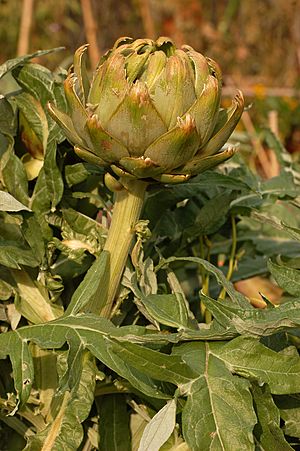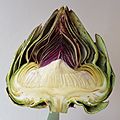Artichoke facts for kids
Quick facts for kids Artichoke |
|
|---|---|
 |
|
| Scientific classification | |
| Kingdom: | |
| (unranked): | |
| (unranked): | |
| (unranked): | |
| Order: | |
| Family: | |
| Subfamily: |
Carduoideae
|
| Tribe: |
Cynareae
|
| Genus: |
Cynara
|
| Species: |
C. scolymus
|
| Binomial name | |
| Cynara scolymus |
|
The Artichoke or Globe Artichoke (Cynara scolymus) is a perennial plant. This means it lives for more than two years. It belongs to the Asteraceae family, which also includes sunflowers and daisies. Artichokes first grew in Southern Europe, especially around the Mediterranean Sea.
People eat the thick scales and the bottom parts of the young flower heads. These parts are considered a special food. The very bottom part of the young flower head is called the "heart."
Contents
What is an Artichoke?
This plant can grow quite tall, reaching about 1.4 to 2 meters (4.5 to 6.5 feet). It has long, arching leaves that are silvery-green and can be 50 to 82 centimeters (20 to 32 inches) long.
The flowers grow in a large head. Before they fully open, they are an edible bud about 8 to 15 centimeters (3 to 6 inches) wide. This bud has many triangular scales. When the flower opens, the small flowers inside are purple.
The parts of the bud that you can eat are mainly the fleshy lower parts of the scales (called bracts) and the base, which is the "heart." The fuzzy mass of tiny, undeveloped flowers in the center of the bud is called the "choke" or "beard." You can't eat the choke, especially in older, larger flowers.
How to Use Artichokes
Artichokes are a tasty vegetable used in many different ways around the world.
Cooking Artichokes
When cooking large globe artichokes, people often cut off most of the stem, leaving only about 5 to 10 millimeters (0.2 to 0.4 inches). To make them easier to eat, you can trim about a quarter of the pointy tips off each scale.
Artichokes are usually boiled or steamed until tender. A cooked artichoke has a mild flavor. The core of the stem tastes similar to the artichoke heart and is also edible.
You can add salt to the water when boiling artichokes. If you cut an artichoke, it might turn brown because of a natural process. To stop this, you can put the cut artichoke in water with a little bit of vinegar or lemon juice.
People often eat artichokes by pulling off one leaf at a time. They scrape the fleshy base of the leaf with their teeth. This part can be dipped in sauces like hollandaise, vinegar, butter, mayonnaise, or lemon juice. The tough, upper part of each leaf is usually thrown away.
Once all the leaves are removed, you can eat the heart. First, you need to peel away and discard the inedible choke from the base. The thin leaves covering the choke are also edible.
Artichoke Dishes Around the World
- Italy: Artichoke hearts preserved in oil are a common topping for the "spring" section of "Four Seasons" pizza. A famous dish in Rome is "Jewish-style artichokes," where whole artichokes are deep-fried until crispy. People also eat the softer parts of artichokes raw, dipped in vinegar and olive oil, or thinly sliced with lemon and olive oil.
- Stuffed Artichokes: Many recipes involve stuffing artichokes. A popular Italian stuffing uses bread crumbs, garlic, herbs like oregano and parsley, grated cheese, and sometimes prosciutto or sausage. This mixture is pushed into the spaces at the base of each leaf and into the center before boiling or steaming.
- Spain: In Spain, people use smaller, more tender artichokes. They might be grilled with olive oil over hot coals, or sautéed with garlic in olive oil. Artichokes are also used in paella (a rice dish) or mixed with eggs to make a tortilla (frittata).
- Greece: A well-known Greek stew is aginares a la polita ("artichokes city-style"). This hearty stew is made with artichoke hearts, potatoes, and carrots, flavored with onion, lemon, and dill. Some places in Greece even have festivals to celebrate their artichoke harvest.
- North Africa, Middle East, Turkey, and Armenia: A favorite filling for stuffed artichoke hearts in these regions often includes ground lamb. The spices used depend on the local cooking style. For example, in Lebanon, the filling might have lamb, onion, tomato, pinenuts, raisins, parsley, dill, mint, black pepper, and allspice. A Turkish vegetarian version uses only onion, carrot, green peas, and salt.
Artichoke Tea
Artichokes can also be used to make a herbal tea. This "artichoke tea" is sold commercially in places like the Da Lat region of Vietnam and in Romania, where it's called Ceai de Anghinare. In Mexico, the flower part is steeped in water to make a tea called alcachofa. It has a slightly bitter, earthy taste.
Images for kids
-
A tea bag containing artichoke tea.
See also
 In Spanish: Yago para niños
In Spanish: Yago para niños











